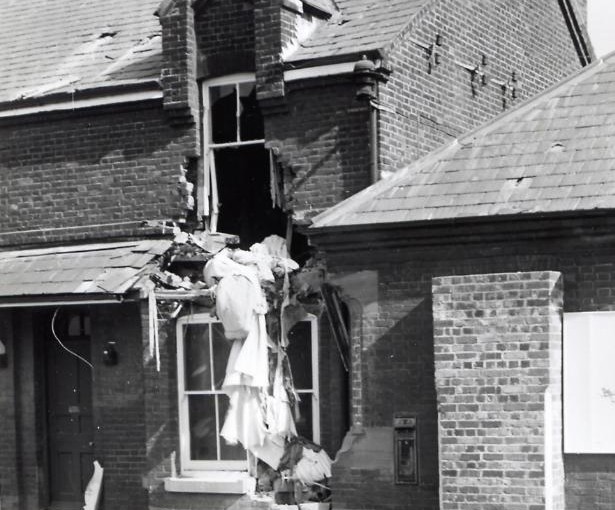By Nathan Dylan Goodwin
The people of Hastings could not have anticipated the scale of death and destruction, which would span almost six, long years in the borough’s history when the country went to war in 1939, a war which left in its wake 154 civilians dead and more than 14,000 properties damaged or destroyed.
The heaviest and worst raid that Hastings would see throughout the war came on 11 March 1943. Between 3.32pm and 3.36pm, 20 Folke-Wulf 190s crossed the channel at Fairlight then came in line abreast at ‘zero feet’ (rooftop height), while a further eight Folke-Wulf 190s patrolled just off shore. This spectacular scene must have frightened residents immensely, as a salvo of 25 powerful H.E. bombs were dropped randomly over the town. Beachy Head, and Dungeness R.A.F. patrols were immediately scrambled to counter this attack as were all available units from Squadrons 609, 308, 64, 403, and 91. The latter three sighted 12 of the enemy aircraft after the attack and gave chase as far as the Somme, but did not succeed in engaging fire. Two Folke-Wulfs, according to official documents, were destroyed by A.A. guns. Allied pilots engaged in the attack later stated that the enemy aircraft were effectively camouflaged with a light-grey glossy paint, making them difficult to see at sea level.

One pilot, who flew several tip-and-run raids against England, was Lt. Leopold Wenger who took many pictures from his plane, including the amazing photograph below of Hastings moments before dropping his bomb load, which as Chris Goss in ‘Luftwaffe Fighter-Bombers over Britain’ suggests was, ‘…an amazing feat for a lone pilot, flying at low-level and high speed and running the gauntlet of the British ground and air defences’.
Seconds prior to devastation: the worst attack on Hastings taken from the cockpit of Wenger’s aircraft, 11 March 1943. Marine Court can be seen to the right of the picture (reproduced by permission of Chris Goss).
The devastation inflicted upon the town was incomparable, with 38 people loosing their lives, 39 seriously injured, and 51 slightly injured. Silverhill suffered particularly badly, when many buildings were completely wrecked, including the mercifully empty St Matthew’s School which took a direct hit. Houses were destroyed in Battle Road, Bury Road, Perth Road, Sedlescombe Road North, Strood Road, Combermere Road, Springfield Road, Aldborough Road, Clarence Road, Salisbury Road, Bohemia Road, Holmesdale Gardens, King Edward Avenue, Broomfield Road, Queen’s Road, Wallinger’s Walk, Alma Villas, and Alma Terrace.
Eileen Parish recalls witnessing the severe Silverhill bombings:
‘My friend Mrs Levett in Perth Road was bombed. She was sitting by the fire when it happened and was burnt all down one side. She later told me that when the firemen were hosing the house, she was trying to catch the water in her mouth because she was so terribly thirsty. She was trapped in the house and it took them a long time to dig her out. She was very badly burned, but she was a tough old bird. Her daughter lived down at London Road and I wanted to tell her what had happened. It was my 21st birthday that day. My uncle, Charlie Bristow drove past and picked me up, he told me he spent his 21st birthday on the firing line in the previous war. We had to go miles, all through Ore just to get to London Road because of the bombings’.
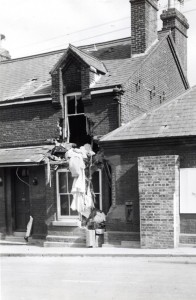
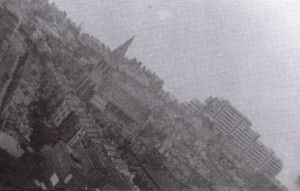
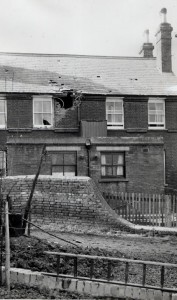
Eileen later went past the Hollington Police Station on Battle Road and saw bundles of bedding hanging from a broken window. Apparently what had occurred was another of the strange incidents caused by the low-flying aircraft, who jettisoned their bombs at such an acute angle. The bomb passed through the front of the Police Station, scooped some linen from the empty bed in the room, then passed through the window, continuing its journey when it finally detonated in Adelaide Road. Eileen later spoke to somebody who was dangerously close to the explosion, ‘…he said he can remember being blown over the houses and said he was looking down at the houses, but he got away from it without much injury’.
Schoolgirl, Brenda Glazier also remembers seeing the devastation caused by the attacks and the subsequent effect on one of her friends:
‘I walked home through Silverhill and it had been virtually destroyed on this Thursday afternoon. The headmistress got us together in groups to walk home and I can remember somebody coming walking up the road and seeing this girl who was with me, and saying to her, ‘Don’t you come down now dear, not now, you go back to school.’ Her father was killed that afternoon’.
The Morrison shelters many times proved their worth throughout the town, with numerous stories of lives being saved because of them. John Bristow’s uncle’s house in King Edward Avenue was among those hit on 11 March 1943. His two aunts, who were busy preparing the house for their other sister’s arrival with her new-born baby, had their lives saved by a Morrison shelter. John recalls the day:
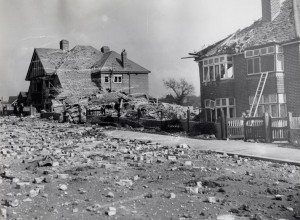
‘My aunts, Mrs Gear and Mrs Gibbs, got into the Morrison shelter as soon as the air raid siren sounded. One dog always ran in the shelter when the sirens sounded, but the other dog wouldn’t come in and he was killed when the house was hit. They were buried in the shelter, but were later dug out’.
For Brenda Wallis, the 11 March attack came dangerously close to her and her family in Sedlescombe Road North:
‘The air raid siren went but the bombs started dropping almost as soon as the siren had gone, we didn’t get very much of a warning. I was actually with my grandmother and she’d got one of these Morrison shelters and we’d got my aunts five month-old baby with us. I remember when all this crashing started and I pushed grandma into the Morrison shelter and I put the baby in with her then scrambled in with them until it had all died down. When I got out, all the dust and dirt was coming down from the sky all around, bits of feather mattresses and beds were coming down and settling everywhere’.
Among those killed was Mrs Emma Riggs Hoad, a teacher in the town for over 30 years, who was killed at her home at 41 Adelaide Road by the bomb blast. Another retired teacher killed, Miss Emma Louisa Giles, who had been headmistress of Silverhill School, died at her home at 52 Vale Road. Many other sad and tragic losses were sustained in this attack, including those of several children, but to list them all would be an all-too-sombre and unnecessary rehearsal.
Although the suffering and ruin had been great, neighbours aided their distraught or homeless friends and the voluntary sectors provided meals and a place to stay, for those who needed it. It is fair to say that the people of the town showed great defiance in the face of the enemy during such incomprehensible destruction and chaos. Spirits were raised the following week by a surprise visit to the town by the Duchess of Kent, who, after a private lunch at Summerfields
with Corporation dignitaries, inspected various branches of the Civil Defence, chatted with bombed-out victims in the Filsham Road rest centre and visiting those sheltering at St Clements Caves. She offered her sympathies to affected townsfolk, and she herself had the reciprocal sympathy from those with whom she chatted, for she herself was in mourning for her husband, the Duke of Kent. Word quickly spread of her low-key arrival and crowds gathered to catch a glimpse of Her Royal Highness about the town.
Although this was the worst raid to hit the town, it was not the last. Hastings would suffer several more severe raids, including devastating attacks by the lethal doodlebugs. The last doodlebug to hit the town landed on 2 August 1944 and peace finally returned to the town.
Excerpts taken from Hastings at War and Hastings Wartime Memories and Photographs by Nathan Dylan Goodwin. More information can be found at: www.nathangoodwin.co.uk
Hastings Town June 2014
All articles, photographs and drawings on this web site are World Copyright Protected. No reproduction for publication without prior arrangement. © World Copyright 2015 Cinque Ports Magazines Rye Ltd., Guinea Hall Lodge Sellindge TN25 6EG
